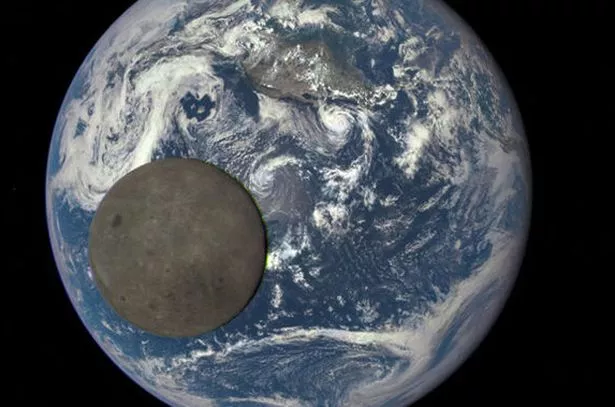The giant space rock is hurtling through space at 40,000 miles per hour but fortunately passed us by
While you were tucked up in bed this morning a two-mile wide asteroid had a 'near miss' with Earth - 15 million miles away.
The asteroid reportedly zoomed passed our planet at around 6.30am today, at a speed of 40,000 miles per hour.
@vespadiary It's much too far away to see— 15 million miles, and poses no threat. Passes Earth at 6:33 am BST.
— Asteroid Watch (@AsteroidWatch) October 10, 2015
NASA had been tracking the giant rock - officially called 86666 (2000 FL10) - on its path through the cosmos.
Experts estimated it to be between 0.7 and 1.6 miles wide - roughly a quarter of the size of Mount Everest and more than 15 times bigger than any other asteroid NASA is watching.
But it has been a long time coming.

Miss: Asteroid 86666 will pass outside of the moon's orbit of the Earth
NasaAsteroid 86666 will pass outside of the moon's orbit of the earthMiss: Asteroid 86666 will pass outside of the moon's orbit of the Earth
The asteroid was first spotted 5,925 days, or 16 years, ago and despite the distance is still classified as a Near-Earth asteroid.
An object is considered a potentially hazardous object (PHO) if it comes within 4,600,000 miles of Earth and is of a size large enough to cause significant damage in the event of an impact.
NASA uses its highly automated collision monitoring system Sentry to continually scan the most current asteroid catalog for possibilities of future impact with Earth over the next 100 years.
And for those worried about the future then you can rest easy for another 23 years.
The next recently observed major object 2015 RN35 is currently projected to come relatively close earth anytime from 2038 to 2114.
None of the thousands of objects on NASA's risk monitoring system are regarded as likely to impact earth greatly.
The maximum detected hazard rating using the Torino Impact Hazard Scale is 10.
A Torino Scale rating of 1 indicates an event that "merits careful monitoring" but currently all threats have been marked at zero.
The ten point scale is defined only for potential impacts less than 100 years in the future.
While you were asleep two-mile wide asteroid had 'near miss' with Earth - Mirror Online
While you were tucked up in bed this morning a two-mile wide asteroid had a 'near miss' with Earth - 15 million miles away.
The asteroid reportedly zoomed passed our planet at around 6.30am today, at a speed of 40,000 miles per hour.
@vespadiary It's much too far away to see— 15 million miles, and poses no threat. Passes Earth at 6:33 am BST.
— Asteroid Watch (@AsteroidWatch) October 10, 2015
NASA had been tracking the giant rock - officially called 86666 (2000 FL10) - on its path through the cosmos.
Experts estimated it to be between 0.7 and 1.6 miles wide - roughly a quarter of the size of Mount Everest and more than 15 times bigger than any other asteroid NASA is watching.
But it has been a long time coming.

Miss: Asteroid 86666 will pass outside of the moon's orbit of the Earth
NasaAsteroid 86666 will pass outside of the moon's orbit of the earthMiss: Asteroid 86666 will pass outside of the moon's orbit of the Earth
The asteroid was first spotted 5,925 days, or 16 years, ago and despite the distance is still classified as a Near-Earth asteroid.
An object is considered a potentially hazardous object (PHO) if it comes within 4,600,000 miles of Earth and is of a size large enough to cause significant damage in the event of an impact.
NASA uses its highly automated collision monitoring system Sentry to continually scan the most current asteroid catalog for possibilities of future impact with Earth over the next 100 years.
And for those worried about the future then you can rest easy for another 23 years.
The next recently observed major object 2015 RN35 is currently projected to come relatively close earth anytime from 2038 to 2114.
None of the thousands of objects on NASA's risk monitoring system are regarded as likely to impact earth greatly.
The maximum detected hazard rating using the Torino Impact Hazard Scale is 10.
A Torino Scale rating of 1 indicates an event that "merits careful monitoring" but currently all threats have been marked at zero.
The ten point scale is defined only for potential impacts less than 100 years in the future.
While you were asleep two-mile wide asteroid had 'near miss' with Earth - Mirror Online